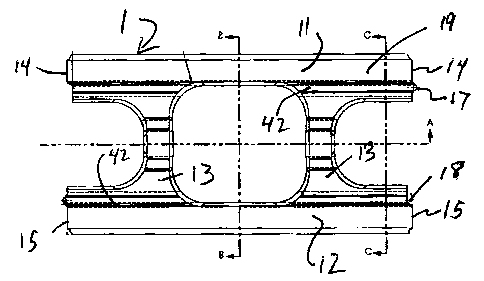Some of the information on this Web page has been provided by external sources. The Government of Canada is not responsible for the accuracy, reliability or currency of the information supplied by external sources. Users wishing to rely upon this information should consult directly with the source of the information. Content provided by external sources is not subject to official languages, privacy and accessibility requirements.
Any discrepancies in the text and image of the Claims and Abstract are due to differing posting times. Text of the Claims and Abstract are posted:
| (12) Patent: | (11) CA 2664371 |
|---|---|
| (54) English Title: | CONCRETE BLOCK |
| (54) French Title: | BLOC DE BETON |
| Status: | Expired and beyond the Period of Reversal |
| (51) International Patent Classification (IPC): |
|
|---|---|
| (72) Inventors : |
|
| (73) Owners : |
|
| (71) Applicants : |
|
| (74) Agent: | MOFFAT & CO. |
| (74) Associate agent: | |
| (45) Issued: | 2012-01-03 |
| (86) PCT Filing Date: | 2007-09-28 |
| (87) Open to Public Inspection: | 2008-04-03 |
| Examination requested: | 2009-03-25 |
| Availability of licence: | N/A |
| Dedicated to the Public: | N/A |
| (25) Language of filing: | English |
| Patent Cooperation Treaty (PCT): | Yes |
|---|---|
| (86) PCT Filing Number: | 2664371/ |
| (87) International Publication Number: | CA2007001739 |
| (85) National Entry: | 2009-03-25 |
| (30) Application Priority Data: | |||||||||
|---|---|---|---|---|---|---|---|---|---|
|
A concrete block for construction, the block having a front wall and a rear wall. The front and rear walls are spaced apart by a pair of transverse webs. Each of the front and rear walls comprises a middle portion and a pair of end portions, wherein the end portions have a uniform thickness that is greater than the thickness of the middle portion.
L'invention concerne un bloc de béton destiné à la construction, qui a une paroi avant et une paroi arrière. Les parois avant et arrière sont séparées par une paire de cloisons transversales. Chacune des parois avant et arrière comprend une partie intermédiaire et une paire de parties d'extrémité, lesdites parties d'extrémité ayant une épaisseur uniforme supérieure à celle de la partie intermédiaire.
Note: Claims are shown in the official language in which they were submitted.
Note: Descriptions are shown in the official language in which they were submitted.

2024-08-01:As part of the Next Generation Patents (NGP) transition, the Canadian Patents Database (CPD) now contains a more detailed Event History, which replicates the Event Log of our new back-office solution.
Please note that "Inactive:" events refers to events no longer in use in our new back-office solution.
For a clearer understanding of the status of the application/patent presented on this page, the site Disclaimer , as well as the definitions for Patent , Event History , Maintenance Fee and Payment History should be consulted.
| Description | Date |
|---|---|
| Time Limit for Reversal Expired | 2017-09-28 |
| Letter Sent | 2016-09-28 |
| Maintenance Request Received | 2015-08-31 |
| Maintenance Request Received | 2014-09-09 |
| Maintenance Request Received | 2013-09-09 |
| Grant by Issuance | 2012-01-03 |
| Inactive: Cover page published | 2012-01-02 |
| Pre-grant | 2011-10-05 |
| Inactive: Final fee received | 2011-10-05 |
| Notice of Allowance is Issued | 2011-05-02 |
| Letter Sent | 2011-05-02 |
| Notice of Allowance is Issued | 2011-05-02 |
| Inactive: Approved for allowance (AFA) | 2011-04-28 |
| Amendment Received - Voluntary Amendment | 2011-01-05 |
| Inactive: S.30(2) Rules - Examiner requisition | 2010-07-09 |
| Inactive: Cover page published | 2009-07-24 |
| Inactive: Correspondence - PCT | 2009-06-10 |
| Letter Sent | 2009-06-04 |
| IInactive: Courtesy letter - PCT | 2009-06-04 |
| Inactive: Notice - National entry - No RFE | 2009-06-04 |
| Inactive: First IPC assigned | 2009-05-23 |
| Correct Applicant Requirements Determined Compliant | 2009-05-22 |
| Application Received - PCT | 2009-05-22 |
| National Entry Requirements Determined Compliant | 2009-03-25 |
| Request for Examination Requirements Determined Compliant | 2009-03-25 |
| All Requirements for Examination Determined Compliant | 2009-03-25 |
| Application Published (Open to Public Inspection) | 2008-04-03 |
There is no abandonment history.
The last payment was received on 2011-09-13
Note : If the full payment has not been received on or before the date indicated, a further fee may be required which may be one of the following
Patent fees are adjusted on the 1st of January every year. The amounts above are the current amounts if received by December 31 of the current year.
Please refer to the CIPO
Patent Fees
web page to see all current fee amounts.
| Fee Type | Anniversary Year | Due Date | Paid Date |
|---|---|---|---|
| Request for exam. (CIPO ISR) – standard | 2009-03-25 | ||
| Basic national fee - standard | 2009-03-25 | ||
| MF (application, 2nd anniv.) - standard | 02 | 2009-09-28 | 2009-09-17 |
| MF (application, 3rd anniv.) - standard | 03 | 2010-09-28 | 2010-08-31 |
| MF (application, 4th anniv.) - standard | 04 | 2011-09-28 | 2011-09-13 |
| Final fee - standard | 2011-10-05 | ||
| MF (patent, 5th anniv.) - standard | 2012-09-28 | 2012-09-13 | |
| MF (patent, 6th anniv.) - standard | 2013-09-30 | 2013-09-09 | |
| MF (patent, 7th anniv.) - standard | 2014-09-29 | 2014-09-09 | |
| MF (patent, 8th anniv.) - standard | 2015-09-28 | 2015-08-31 |
Note: Records showing the ownership history in alphabetical order.
| Current Owners on Record |
|---|
| TONY AZAR |
| Past Owners on Record |
|---|
| None |